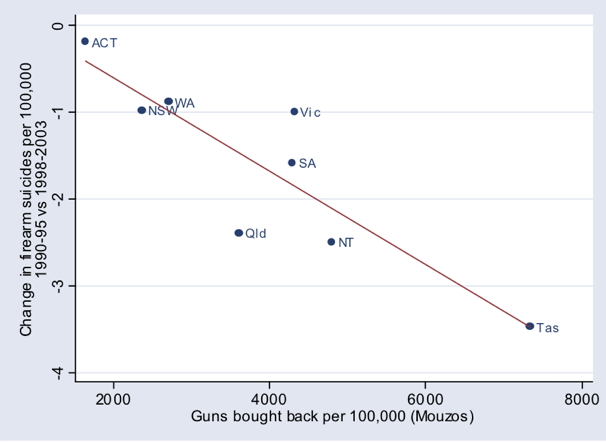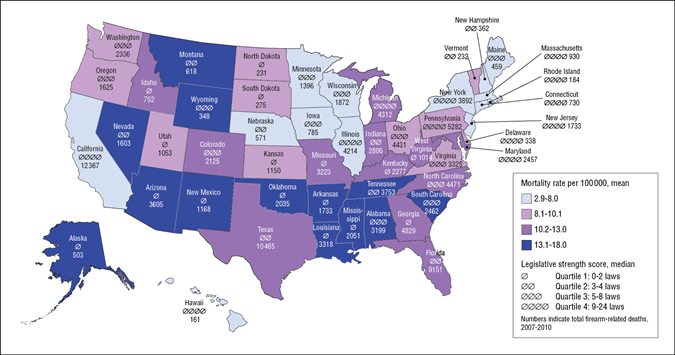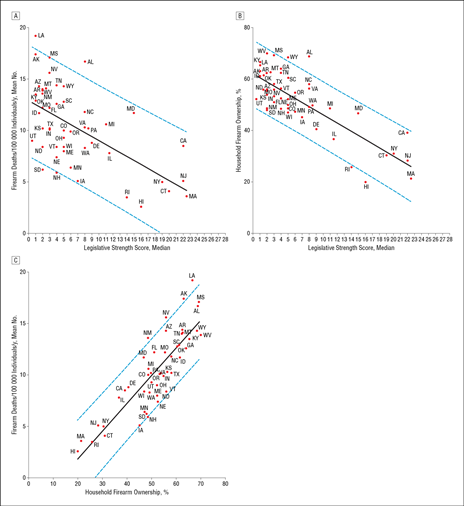According to the BBC article Missouri gun murders 'rose after law repeal',
Reporting soon in the Journal of Urban Health, the researchers will say that the [gun control law's] repeal resulted in an immediate spike in gun violence and murders.
The study links the abandonment of the background check to an additional 60 or so murders occurring per year in Missouri between 2008 and 2012.
"Coincident exactly with the policy change, there was an immediate upward trajectory to the homicide rates in Missouri," said Prof Daniel Webster, director of the Johns Hopkins Center for Gun Policy and Research.
It looks like the paper cited has sensible controls for the conclusions:
"That upward trajectory did not happen with homicides that did not involve guns; it did not occur to any neighbouring state; the national trend was doing the opposite – it was trending downward; and it was not specific to one or two localities – it was, for the most part, state-wide," he told BBC News.
The team said it took account of changes that occurred in policing levels and incarceration rates, trends in burglaries, and statistically controlled for other possible confounding factors such as shifts in unemployment and poverty.
According to the BBC the underlying study is to-be reported in the Journal of Urban Health. If vetted, the study would be compelling evidence that the absence of gun control laws correlates with higher gun violence and murders.
Edit Referencing CBC story Mass shootings in the U.S.: Guns, glory, broken dreams A new study sheds light on why mass shootings in the U.S. are 'an exceptionally American problem', Aug 25, 2015. This article states that Adam Lankford recently presented at the American Sociological Association's conference the results along the lines of the following:
Using data compiled by the New York City Police Department in its 2012 report on active shooting incidents in the U.S. and around the world, as well as data from a 2014 FBI report, Lankford determined that the U.S. had 90 mass shooting incidents during that time frame.
...
America's gun culture and the widespread availability of firearms, contributes to the country's mass shooting problem, the study says. It found that American mass shooters were more likely to arm themselves with multiple weapons, though they killed fewer people than shooters in other countries.
...
While Lankford's study suggested a strong link between the civilian firearm ownership rate and the number of public mass shooters in the United States, he said there could be other factors that make the U.S. especially prone to public mass shooting incidents.
America puts more pressure on its citizens to succeed professionally and financially than other countries, Lankford discusses in his study, and when Americans have bad experiences at work or school and fail to achieve their goals, they are more likely to respond with acts of violence.
...
Then there's also the idolization of fame, which appears uniquely American, according to Lankford. Increasingly in the U.S., especially among young people, becoming famous is considered the ultimate form of success.
...
"Unfortunately, due to some combination of strains, mental illness and American idolization of fame, some mass shooters succumb to terrible delusions of grandeur, and seek fame and glory through killing," his study says. They realize that the only way they will become a household name is by killing innocent people.
Which is all to say, according to the article and the underlying study the exceptionally high number of American gun massacres is linked to:
- gun prevalence,
- gun culture,
- mental illness,
- cultural expectations for success, and
- desire for fame.
That is to say: Gun control would reduce the prevalence, but I think it is fair to say that one should be cautious of using gun control as a solution because the underlying demand for mass murders in America will remain (as created by mental illness, cultural expectations, and desire for fame).



